The Fastest Growing Largest Cities in the World: A Look at Urban Expansion
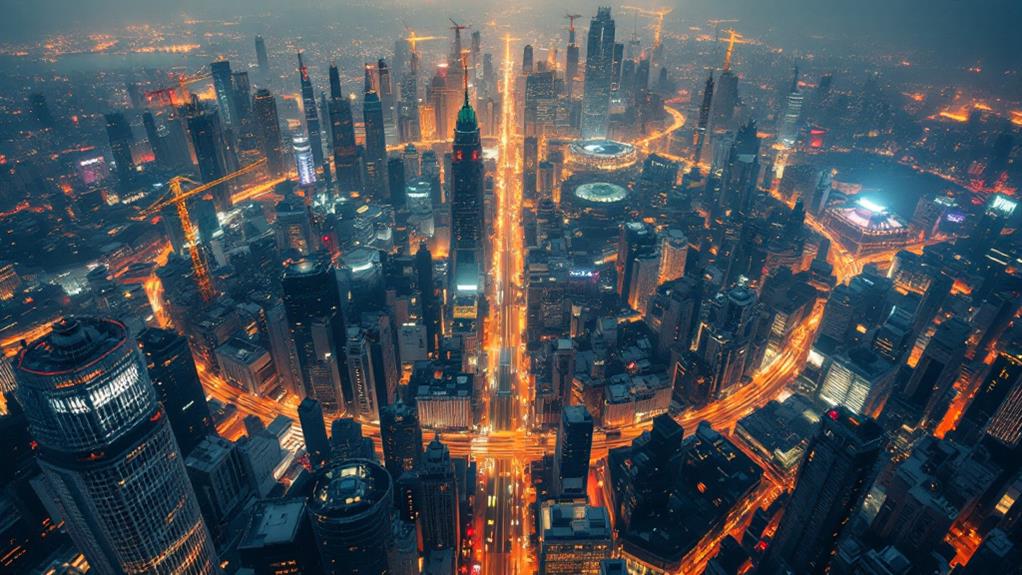
You're witnessing a global urban boom, particularly in Asia and Africa, where cities are expanding rapidly. High fertility rates and urban migration bring people to cities like Malappuram, India, and Abuja, Nigeria, driving massive growth. Cities attract people seeking better jobs, healthcare, and education. As these urban centers swell, they stretch existing infrastructure, creating challenges like housing shortages and environmental strain. However, the fast growth also brings opportunities and the need for sustainable planning. Investigate how emerging megacities such as Kinshasa and Hyderabad are handling these dynamics and reshaping our world's urban future.
Global Urbanization Trends
By 2050, a striking 68% of the world's population will live in urban areas, underscoring a powerful shift toward urbanization. You're witnessing a transformation that sees more people flocking to cities than ever before. This urban migration is fueled by individuals seeking better economic opportunities and improved living conditions. The move towards urban living is not uniform across the globe, though. In particular, India, China, and Nigeria stand out as major contributors to this urban shift, accounting for 35% of the projected urban population growth from 2018 to 2050.
As you investigate these trends, consider how different regions experience urban population growth. For example, Sub-Saharan Africa's fertility rate of 4.6 births per woman is well above the global average of 2.4, contributing greatly to rapid urban growth in the region. In contrast, Europe is expected to face a population decrease by 2025, highlighting a stark difference in urbanization trends. Africa's anticipated growth rate of 2.46% further emphasizes this disparity. These dynamics will shape the future landscape of urban areas, and understanding them is essential for planning sustainable urban environments that can accommodate the growing urban populace.
Key Drivers of City Growth
The momentum of urbanization stems from multiple compelling drivers that shape the expansion of cities worldwide. At the forefront is urban migration, where countless individuals leave rural areas in search of economic opportunities. Cities promise better livelihoods, attracting a steady stream of people and contributing to a burgeoning urban population. This migration fuels cities' rapid growth, as new residents settle in search of jobs and improved living conditions.
High fertility rates, particularly in regions like Sub-Saharan Africa, further accelerate urban population growth. With an average of 4.6 births per woman, these cities experience significant population surges. Infrastructure development also plays a vital role. As cities expand, the construction of transportation systems and housing projects becomes fundamental. These developments accommodate the influx of new residents, promoting seamless urban expansion.
Additionally, improved healthcare and living standards in urban areas contribute to longer life expectancies and lower mortality rates. As a result, cities experience sustained population increases. Political stability in some regions acts as a magnet for those seeking safety and prosperity, drawing more people into urban centers. Together, these factors create a dynamic environment for the rapid growth and transformation of the world's largest cities.
Fastest Growing Urban Centers
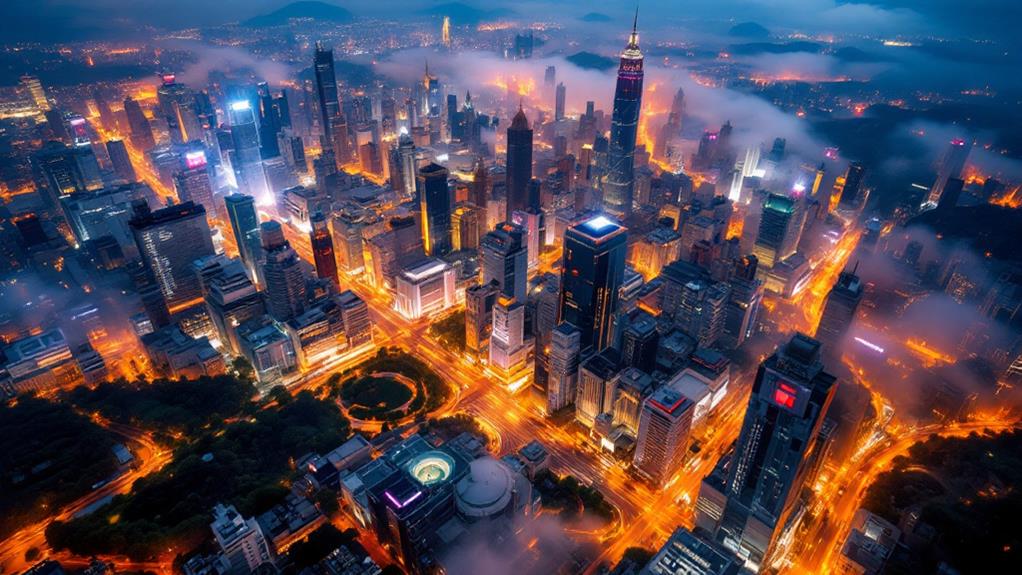
With urbanization drivers in mind, let's investigate some of the fastest growing urban centers around the globe. Malappuram, India, leads the pack with an astonishing 44% growth rate between 2015 and 2020. This rapid expansion reflects the city's appeal and its burgeoning urban population. Can Tho, Vietnam, isn't far behind, boasting a 37% increase, highlighting Asia's prominent role in urban growth. These cities exemplify the fastest growing urban areas, showing how urban hubs are transforming rapidly.
In Bangladesh, Rupganj experienced a 10.2% growth rate, indicating considerable urban expansion. Meanwhile, Abuja, Nigeria, saw a remarkable 34% rise in its urban population. Nigeria's Gwagwalada also recorded a notable 9.5% increase, reinforcing Africa's contribution to the list of fastest growing urban centers. These statistics underscore a broader trend where developing regions, particularly in Asia and Africa, are at the forefront of urbanization.
Cities like Delhi and Shanghai continue welcoming new residents, contributing considerably to their status as major urban centers. As you observe these trends, it's clear that urban populations are swelling, reshaping the global urban landscape and setting the stage for future developments.
Emerging Megacities Worldwide
Many cities worldwide are on the brink of becoming megacities, driven by rapid urbanization and population surges. By 2030, eight new megacities are anticipated to emerge, with Kinshasa in the Democratic Republic of the Congo leading the charge. Its population is expected to jump from 15.6 million to 21.9 million. Not far behind is Hyderabad, India, projected to grow from 10.5 million to 12.7 million. These swelling numbers highlight the shifting dynamics of global urbanization, with a significant concentration in developing countries.
Currently, there are 35 recognized megacities, but this number is set to expand as more cities cross the 10 million population mark. For instance, Dar es Salaam, Tanzania, and Chengdu, China, are making strides, with populations expected to reach 10.8 million and 10.7 million, respectively, by 2030. These emerging megacities illustrate the rapid urban expansion underway in many parts of the world.
The total population of megacities is projected to rise by 266 million by 2050. This surge underscores the importance of planning and sustainable development in these burgeoning urban areas. You're witnessing a global transformation, as cities adapt to accommodate their ever-growing populations.
Population Surges in Africa
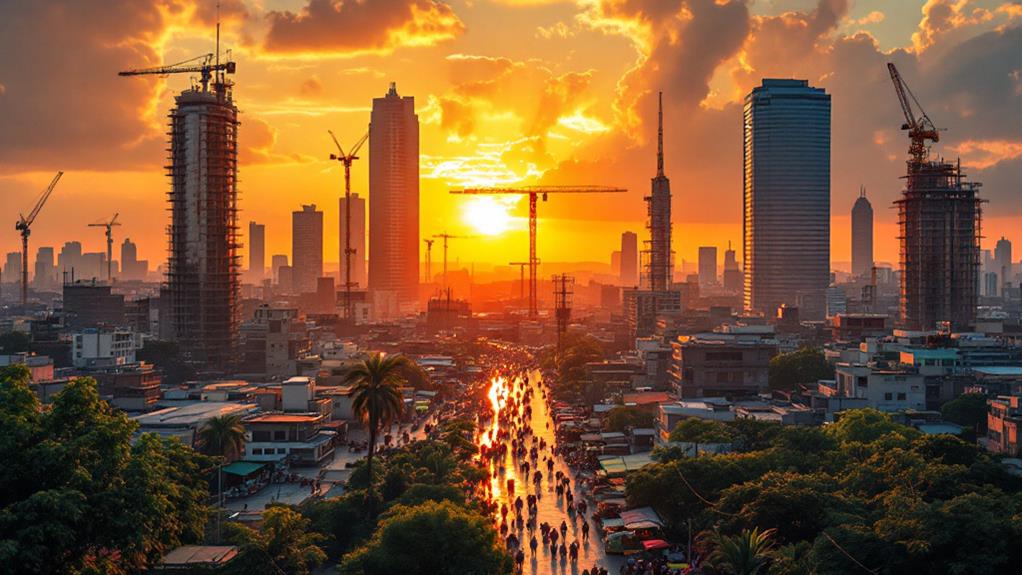
Africa's urban landscape is rapidly transforming as it hosts the majority of the world's fastest-growing cities. With 15 out of the top 20 cities witnessing significant population surges, it's clear that the continent is experiencing an urban revolution. These rapidly growing urban populations are reshaping the social and economic dynamics across the region.
Consider these examples:
- Gwagwalada, Nigeria: This city is projected to see a 6.46% increase, with its population rising from 410,000 in 2020 to 566,000 by 2025. Such growth rates signify remarkable urban expansion.
- Lokoja, Nigeria: Here, you'll find a growth rate of 5.93%, elevating the population from 692,000 in 2020 to approximately 931,000 by 2025. This surge highlights the city's burgeoning appeal.
- Kabinda, DRC: Anticipated to grow by 6.37%, Kabinda's population is expected to jump from 466,000 in 2020 to 640,000 by 2025, demonstrating significant urban development.
In Angola, Uige is experiencing a growth rate of 5.92%, with the number of inhabitants increasing from 511,000 in 2020 to 687,000 by 2025. Each of these cities exemplifies the dynamic and rapidly changing urban environments across Africa.
Economic Opportunities and Migration
Cities around the world are transforming as they become magnets for those seeking economic opportunities and better lives. You can see this trend clearly in places like Gwagwalada, Nigeria, and Rupganj, Bangladesh, where growth rates soar to 6.46% and 6.36%, respectively. This explosive increase stems from people migrating from rural areas, drawn by the promise of jobs and improved living standards. Urban migration is a key factor driving population increases, as individuals and families move to cities in search of better livelihoods.
By 2050, India, China, and Nigeria are poised to account for 35% of the global urban population growth. Economic prospects in these countries are major attractions, pulling people from less developed regions. The average fertility rate in Sub-Saharan Africa, at 4.6 births per woman, also contributes to this rapid urban expansion. As younger populations flock to cities, the urban population continues to swell.
In conjunction with jobs, urban areas offer better access to services like education and healthcare. These benefits further incentivize rural populations to relocate, highlighting the powerful draw of economic opportunities that cities provide. Your understanding of urban growth must consider these dynamics as cities evolve globally.
Infrastructure and Expansion Challenges
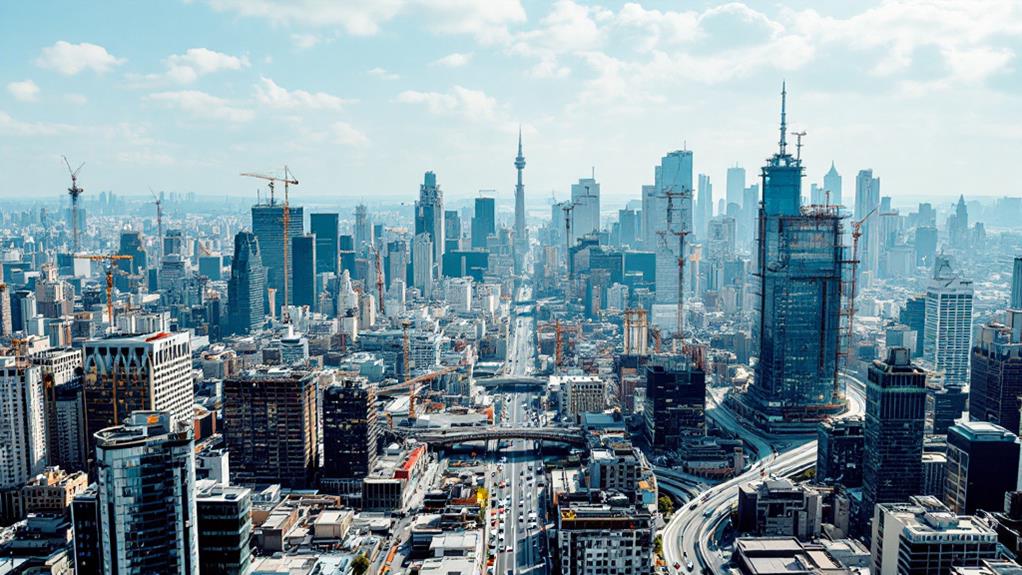
Although rapid urban growth offers economic opportunities, it also poses significant infrastructure challenges. In urban centres like Lagos, Nigeria, less than 10% of residents have sewer connections, and under 20% have access to tap water. These figures highlight the pressing need for improved infrastructure. As cities expand, you often encounter inadequate transport systems and public services that can't keep pace with the growing population. In Kinshasa, DRC, projected to reach a population of 21.9 million by 2030, the strain on infrastructure is evident and demanding.
To navigate these challenges effectively, consider the following areas:
- Housing Demand: Fast-growing cities like Gwagwalada, Nigeria, face housing shortages, leading to informal settlements and slums.
- Essential Services: Urban centres such as Malappuram, India, struggle to provide necessary services like health care, education, and sanitation due to rapid population growth.
- Infrastructure Development: In cities like Dar es Salaam, Tanzania, insufficient infrastructure results in congestion and environmental issues.
Addressing these challenges requires strategic planning and investment in infrastructure to improve living conditions and support sustainable growth in these burgeoning urban centres.
Environmental Impact of Urban Growth
In the present rapidly urbanizing world, the environmental impact of urban growth can't be ignored. As you witness the rapid expansion of megacities, you see a rise in challenges like increased pollution levels. Cities such as Delhi and Dhaka face severe air quality issues, mainly due to high vehicle emissions and industrial activities. The unchecked growth of urban areas leads to habitat destruction and biodiversity loss, especially in Africa, where natural landscapes make way for infrastructure and housing.
You also encounter waste management crises in these expanding urban areas. Places like Lagos struggle to manage their waste effectively, polluting waterways and posing considerable health risks to residents. Furthermore, the urban heat island effect becomes more pronounced. Densely populated cities absorb and retain more heat, causing higher temperatures and escalating energy demands for cooling. Cities like Kinshasa and Hyderabad are prime examples of this phenomenon.
To combat these environmental challenges, sustainable urban planning becomes essential. Although not the focus here, integrating green infrastructure and efficient public transportation can notably reduce the carbon footprints of growing megacities. As urban areas continue to grow, addressing these environmental impacts remains an urgent priority for a sustainable future.
Future Urban Planning Strategies
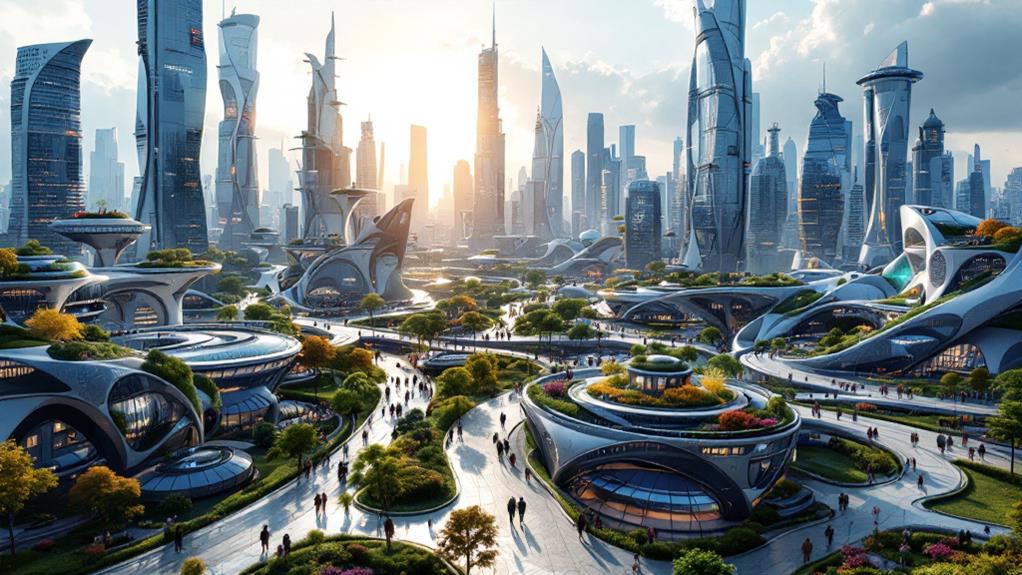
As urban centers face mounting environmental challenges, it's clear that future urban planning strategies must prioritize sustainable development. With over 500 million residents expected to move to the world's largest cities by 2050, particularly in Africa and the Asia Pacific, you'll need to rethink how these urban areas function. Creating efficient infrastructure is key to supporting this surge in the urban population. You'll need to focus on improving housing, transportation, and public services to meet the demands of this growth.
To address these challenges, consider:
- Reducing slum development: This can improve living conditions and boost access to vital services like clean water and sanitation.
- Incorporating demographic trends: Recognize the younger demographic profiles in African megacities, and guarantee educational and employment opportunities are available.
- Promoting collaboration: Governments, private sectors, and communities must work together to manage migration patterns and build resilient urban environments.
Regional Urbanization Statistics
Urbanization across the globe is reshaping regions at an unprecedented pace, and the statistics tell a compelling story. By 2050, 68% of the global population is expected to reside in urban areas, with the world's fastest growing cities emerging in Africa and the Asia Pacific. This shift underscores how urban population dynamics are changing rapidly, especially in developing regions.
You'll notice that India, China, and Nigeria are at the forefront of this transformation. They're projected to contribute to 35% of the global urban population growth from 2018 to 2050. This significant demographic shift points to these countries as key players in future urban landscapes. In Africa, you'll see urbanization rates ascend from the current 43% due to high birth rates and migration to cities. These trends position African cities as some of the world's fastest growing.
In contrast, you'll find Europe facing a different scenario. Its urban population is set to decline by -0.02% by 2050, highlighting how urbanization trends aren't uniform across the globe. While low and middle-income countries experience rapid city growth, more developed regions might see stagnation or even declines, emphasizing diverse regional challenges in urban planning.



